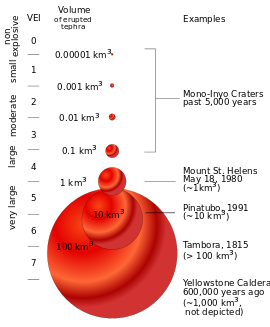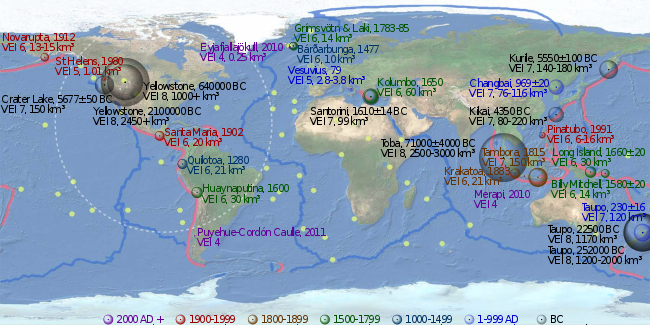Volcanic Explosivity Index

The Volcanic Explosivity Index (VEI) is a relative measure of the explosiveness of volcanic eruptions. It was devised by Chris Newhall of the United States Geological Survey and Stephen Self at the University of Hawaii in 1982.
Volume of products, eruption cloud height, and qualitative observations (using terms ranging from "gentle" to "mega-colossal") are used to determine the explosivity value. The scale is open-ended with the largest eruptions in history given a magnitude of 8. A value of 0 is given for non-explosive eruptions, defined as less than 10,000 m3 (350,000 cu ft) of tephra ejected; and 8 representing a mega-colossal explosive eruption that can eject 1.0×1012 m3 (240 cubic miles) of tephra and have a cloud column height of over 20 km (66,000 ft). The scale is logarithmic, with each interval on the scale representing a tenfold increase in observed ejecta criteria, with the exception of between VEI-0, VEI-1 and VEI-2.[1]
Classification[]
With indices running from 0 to 8, the VEI associated with an eruption is dependent on how much volcanic material is thrown out, to what height, and how long the eruption lasts. The scale is logarithmic from VEI-2 and up; an increase of 1 index indicates an eruption that is 10 times as powerful. As such, there is a discontinuity in the definition of the VEI between indices 1 and 2. The lower border of the volume of ejecta jumps by a factor of one hundred, from 10,000 to 1,000,000 m3 (350,000 to 35,310,000 cu ft), while the factor is ten between all higher indices. In the following table, the frequency of each VEI indicates the approximate frequency of new eruptions of that VEI or higher.
| VEI | Ejecta volume (bulk) |
Classification | Description | Plume | Frequency | Tropospheric injection |
Stratospheric injection[2] |
|---|---|---|---|---|---|---|---|
| Examples | |||||||
| 0 | < 104 m3 | Hawaiian | Effusive | < 100 m | continuous | negligible | none |
| Hoodoo Mountain (c. 7050 BC),[3] Erebus (1963), Surtsey (1963-1967), Kīlauea (1977), Socorro Island (1993), Mawson Peak (2006), Dallol (2011), Piton de la Fournaise (2017) | |||||||
| > 104 m3 | Hawaiian / Strombolian | Gentle | 100 m – 1 km | daily | minor | none | |
| Stromboli (since Roman times), Nyiragongo (2002), Raoul Island (2006) | |||||||
| 2 | > 106 m3 | Strombolian / Vulcanian | Explosive | 1–5 km | every two weeks | moderate | none |
| Unzen (1792), Cumbre Vieja (1949, 1971), Galeras (1993), Sinabung (2010), El Hierro (2011-2012), Mount Stromboli (2019), Whakaari (2019) | |||||||
| 3 | > 107 m3 | Strombolian / Vulcanian / Peléan / Sub-Plinian | Catastrophic | 3–15 km | 3 months | substantial | possible |
| Lassen Peak (1915), Mount Vesuvius (1944), Hibok-Hibok (1948-1953), Mount Etna (1979), Nevado del Ruiz (1985), Mount Redoubt (1989), Soufrière Hills (1995), Jabal al-Tair (2007), Ontake (2014), Kīlauea (2018), Volcán de Fuego (2018), Anak Krakatoa (2018) Mount Sinabung (2020, 2021), Cumbre Vieja (2021), Mount Semeru (2021) | |||||||
| 4 | > 0.1 km3 | Peléan / Plinian/Sub-Plinian | Cataclysmic | > 10 km (Plinian or sub-Plinian) | 18 months | substantial | definite |
| Laki (1783), Kīlauea (1790), Mayon (1814), Makian (1861), Cotopaxi (1877), Mount Bandai (1888), Pelée (1902), Kelud (1919), Rabaul (1937), Mount Lamington (1951), Galunggung (1982), Chaitén (2008), Eyjafjallajökull (2010), Mount Merapi (2010), Nabro (2011), Mount Sinabung (2014), Calbuco (2015), Ulawun (2019), Taal (2020), La Soufrière (2021) | |||||||
| 5 | > 1 km3 | Peléan / Plinian | Paroxysmic | > 10 km (Plinian) | 12 years | substantial | significant |
| Mount Vesuvius (79), Mount Fuji (1707), Katla (1625, 1721, 1755), Galunggung (1822), Cosigüina (1835), Shiveluch (1854), Askja (1875), Mount Tarawera (1886), Cerro Azul (1932), Agung (1963), Mount St. Helens (1980), El Chichón (1982), Hudson (1991), Puyehue (2011) | |||||||
| 6 | > 10 km3 | Plinian / Ultra-Plinian | Colossal | > 20 km | 50–100 yrs | substantial | substantial |
| Laacher See (c. 10,950 BC), Nevado de Toluca (8,550 BC), Veniaminof (c. 1750 BC), Lake Ilopango (450), Ceboruco (930), Quilotoa (1280), Bárðarbunga (1477), Huaynaputina (1600), Krakatoa (1883), Santa Maria (1902), Novarupta (1912), Mount Pinatubo (1991) | |||||||
| 7 | > 100 km3 | Ultra-Plinian | Super-colossal | > 20 km | 500–1,000 yrs | substantial | substantial |
| Mesa Falls Tuff (1,300,000 BC), Valles Caldera (1,264,000 BC), Phlegraean Fields (37,000 BC), Aira Caldera (22,000 BC), Kurile Lake (c. 6460 BC) Mount Mazama (c. 5,700 BC), Kikai Caldera (4,300 BC), Cerro Blanco (c. 2300 BC), Santorini (c. 1620 BC), Taupō (180), Paektu (946), Samalas (1257), Mount Tambora (1815) | |||||||
| 8 | > 1,000 km3 | Ultra-Plinian | Mega-colossal | > 20 km | > 50,000 yrs[4][5] | vast | vast |
| Wah Wah Springs (30,000,000 BC), La Garita (26,300,000 BC), Ōdai Caldera (13,700,000 BC), Cerro Galán (2,200,000 BC), Huckleberry Ridge Tuff (2,100,000 BC), Yellowstone (630,000 BC), Whakamaru (in TVZ) (254,000 BC),[6] Toba (74,000 BC), Taupō (26,500 BC) | |||||||
About 40 eruptions of VEI-8 magnitude within the last 132 million years (Mya) have been identified, of which 30 occurred in the past 36 million years. Considering the estimated frequency is on the order of once in 50,000 years,[4] there are likely many such eruptions in the last 132 Mya that are not yet known. Based on incomplete statistics, other authors assume that at least 60 VEI-8 eruptions have been identified.[7][8] The most recent is Lake Taupō's Oruanui eruption, more than 27,000 years ago, which means that there have not been any Holocene eruptions with a VEI of 8.[9]
There have been at least 10 eruptions of VEI-7 in the last 11,700 years. There are also 58 Plinian eruptions, and 13 caldera-forming eruptions, of large, but unknown magnitudes. By 2010, the Global Volcanism Program of the Smithsonian Institution had cataloged the assignment of a VEI for 7,742 volcanic eruptions that occurred during the Holocene (the last 11,700 years) which account for about 75% of the total known eruptions during the Holocene. Of these 7,742 eruptions, about 49% have a VEI of 2 or less, and 90% have a VEI of 3 or less.[10]
Limitations[]
Under the VEI, ash, lava, lava bombs, and ignimbrite are all treated alike. Density and vesicularity (gas bubbling) of the volcanic products in question is not taken into account. In contrast, the DRE (dense-rock equivalent) is sometimes calculated to give the actual amount of magma erupted. Another weakness of the VEI is that it does not take into account the power output of an eruption, which makes the VEI extremely difficult to determine with prehistoric or unobserved eruptions.
Although VEI is quite suitable for classifying the explosive magnitude of eruptions, the index is not as significant as sulfur dioxide emissions in quantifying their atmospheric and climatic impact.[11]
Lists of large eruptions[]

- Timeline of volcanism on Earth (mostly VEI-6, within 2 kya)
- List of large volcanic eruptions of the 19th century (≥ VEI-4)
- List of large volcanic eruptions of the 20th century (≥ VEI-4)
- List of large volcanic eruptions in the 21st century (≥ VEI-4)
- List of large historical volcanic eruptions (VEI-5-7 within recorded history)
- List of large volcanic eruptions (mostly VEI-6–8, within 50 Mya)
- List of largest volcanic eruptions (VEI-7–8, mostly within 500 Mya)
See also[]
- Supervolcano – Volcano that has erupted 1000 cubic km in a single eruption
- Decade Volcanoes – Set of sixteen volcanoes noted for their eruptive history and proximity to densely populated areas
- Dispersal index – Indicator of spread of volcanic ejecta
- Lists of volcanoes
- List of natural disasters by death toll
- List of volcanic eruptions by death toll
References[]
- ^ Newhall, Christopher G.; Self, Stephen (1982). "The Volcanic Explosivity Index (VEI): An Estimate of Explosive Magnitude for Historical Volcanism" (PDF). Journal of Geophysical Research. 87 (C2): 1231–1238. Bibcode:1982JGR....87.1231N. doi:10.1029/JC087iC02p01231. Archived from the original (PDF) on December 13, 2013.
- ^ "Volcanic Explosivity Index (VEI)". Global Volcanism Program. Smithsonian National Museum of Natural History. Archived from the original on November 10, 2011. Retrieved August 21, 2014.
- ^ "Hoodoo Mountain: Eruptive History". Global Volcanism Program. Smithsonian Institution. Retrieved 2021-07-15.
- ^ a b Dosseto, A. (2011). Turner, S. P.; Van-Orman, J. A. (eds.). Timescales of Magmatic Processes: From Core to Atmosphere. Wiley-Blackwell. ISBN 978-1-4443-3260-5.
- ^ Rothery, David A. (2010), Volcanoes, Earthquakes and Tsunamis, Teach Yourself
- ^ Froggatt, P. C.; Nelson, C. S.; Carter, L.; Griggs, G.; Black, K. P. (13 February 1986). "An exceptionally large late Quaternary eruption from New Zealand". Nature. 319 (6054): 578–582. Bibcode:1986Natur.319..578F. doi:10.1038/319578a0. S2CID 4332421.
- ^ BG, Mason (2004). "The size and frequency of the largest explosive eruptions on Earth". Bull Volcanol. 66 (8): 735–748. Bibcode:2004BVol...66..735M. doi:10.1007/s00445-004-0355-9. S2CID 129680497.
- ^ Bryan, S.E. (2010). "The largest volcanic eruptions on Earth" (PDF). Earth-Science Reviews. 102 (3–4): 207–229. Bibcode:2010ESRv..102..207B. doi:10.1016/j.earscirev.2010.07.001.
- ^ Mason, Ben G.; Pyle, David M.; Oppenheimer, Clive (2004). "The size and frequency of the largest explosive eruptions on Earth". Bulletin of Volcanology. 66 (8): 735–748. Bibcode:2004BVol...66..735M. doi:10.1007/s00445-004-0355-9. S2CID 129680497.
- ^ Siebert, L.; Simkin, T.; Kimberly, P. (2010). Volcanoes of the World (3rd ed.). University of California Press. pp. 28–38. ISBN 978-0-520-26877-7.
- ^ Miles, M. G.; Grainger, R. G.; Highwood, E. J. (2004). "Volcanic Aerosols: The significance of volcanic eruption strength and frequency for climate" (PDF). Quarterly Journal of the Royal Meteorological Society. 130 (602): 2361–2376. Bibcode:2004QJRMS.130.2361M. doi:10.1256/qj.03.60.
External links[]
- VEI glossary entry from a USGS website
- How to measure the size of a volcanic eruption, from The Guardian
- The size and frequency of the largest explosive eruptions on Earth, a 2004 article from the Bulletin of Volcanology
- List of Large Holocene Eruptions (VEI > 4) from the Smithsonian Global Volcanism Program
- Volcanology
- Hazard scales
- 1982 introductions